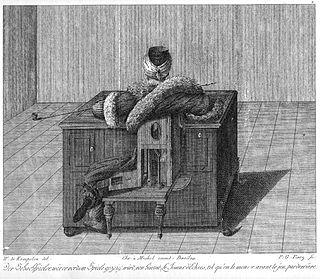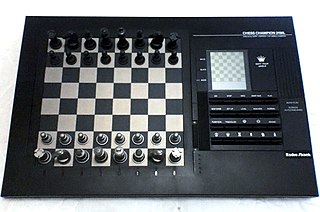Johann Nepomuk Maelzel was a German inventor, engineer, and showman, best known for manufacturing a metronome and several music automatons, and displaying a fraudulent chess machine. He worked with Beethoven to compose a song.
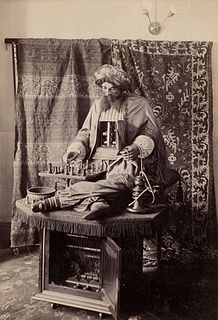
Ajeeb was a chess-playing "automaton", created by Charles Hooper, first presented at the Royal Polytechnical Institute in 1868. A particularly intriguing piece of faux mechanical technology, it drew scores of thousands of spectators to its games, the opponents for which included Harry Houdini, Theodore Roosevelt, and O. Henry.
"Moxon's Master" is a short story by American writer Ambrose Bierce, which speculates on the nature of life and intelligence. It describes a chess-playing automaton that murders its creator. First published in The San Francisco Examiner on April 16, 1899, it is one of the first descriptions of a robot in English-language literature written much before the word 'robot' came to be used.
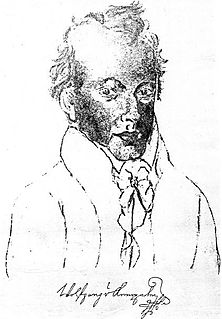
Wolfgang von Kempelen was a Hungarian author and inventor, known for his chess-playing "automaton" hoax The Turk and for his speaking machine.

Game Over: Kasparov and the Machine is a 2003 documentary film by Vikram Jayanti about the match between Garry Kasparov, the highest rated chess player in history and the World Champion for 15 years (1985–2000), and Deep Blue, a chess-playing computer created by IBM. It was coproduced by Alliance Atlantis and the National Film Board of Canada.

El Ajedrecista is an automaton built in 1912 by Leonardo Torres y Quevedo, one of the first autonomous machines capable of playing chess. As opposed to the human-operated The Turk and Ajeeb, El Ajedrecista was a true automaton built to play chess without human guidance. It played an endgame with three chess pieces, automatically moving a white king and a rook to checkmate the black king moved by a human opponent.

Chess became a source of inspiration in the arts in literature soon after the spread of the game to the Arab World and Europe in the Middle Ages. The earliest works of art centered on the game are miniatures in medieval manuscripts, as well as poems, which were often created with the purpose of describing the rules. After chess gained popularity in the 15th and 16th centuries, many works of art related to the game were created. One of the most well-known, Marco Girolamo Vida's Scacchia ludus, written in 1527, made such an impression on the readers that it singlehandedly inspired other authors to create poems about chess.

"Maelzel's Chess Player" (1836) is an essay by Edgar Allan Poe exposing a fraudulent automaton chess player called The Turk, which had become famous in Europe and the United States and toured widely. The fake automaton was invented by Wolfgang von Kempelen in 1769 and was brought to the U.S. in 1825 by Johann Nepomuk Mälzel after von Kempelen's death.
François Pelletier was a French illusionist, famed in his time for his use of magnets as an entertainment basis for his act. His reputation was such that he was invited to perform at the court of Maria Theresa of Austria at Schönbrunn Palace in 1769. His act inspired the construction of the purported chess-playing automaton The Turk, following observation of the performance by the Hungarian Wolfgang von Kempelen.

Karl Gottlieb von Windisch was a Hungarian German writer who produced a series of letters that were published as "Briefe über den Schachspieler von Kempelen nebst drey Kupferstichen die diese berühmte Maschine vorstellen", translated as "Inanimate Reason; or a Circumstantial Account of That Astonishing Piece of Mechanism, M. de Kempelen's Chess-Player; Now Exhibiting at No. 9 Savile-Row, Burlington Gardens", following a series of performances of The Turk that he attended. The letters have been cited often since their publication in attempts to uncover the secret of the machine. Windisch spoke Slovak and Hungarian and was the first publisher of an academic Journal in Eastern Europe.
Joseph Friedrich Freiherr von Racknitz (1744–1818) was part of the Racknitz family from Steiermark, Germany, a family that originated in 1180 at Castle Perneck. Residing in Dresden, he worked as the equivalent of a court marshal, and published an often-cited pamphlet about the chess-playing machine The Turk, Ueber den Schachspieler des Herrn von Kempelen, nebst einer Abbildung und Beschreibung seiner Sprachmachine, which attempted to reveal the secret behind the purported automaton using new illustrations as well as personal observations.
William Schlumberger was a European chess master. He is known to have taught Pierre Charles Fournier de Saint-Amant to play chess and as the operator of The Turk, a chess-playing machine which was purported to be an automaton. It was Bavarian musician and showman Johann Nepomuk Mälzel who hired him to operate The Turk. Schlumberger acted as the Turk's director in Europe and in the United States until his death from yellow fever in 1838.

John Gaughan is an American manufacturer of magic acts and equipment for magicians based in Los Angeles, California. His style of work is classic, not based heavily on machinery and technology.

The Chess Monthly was a short-lived monthly chess magazine produced from January 1857 and May 1861 in the United States. Edited by professional diplomat and linguistics professor Daniel Willard Fiske, it was co-edited for a time by Paul Morphy. The magazine was based in New York City.
This article documents the progress of significant human–computer chess matches.
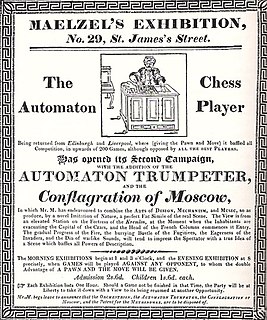
Jacques François Mouret (1787–1837) was a French chess master of the early 19th century who became chess tutor of the future Louis Philippe I and was one of the most successful operators of The Turk, a famous chess-playing automaton.
Hyacinthe Henri Boncourt was one of the leading chess players in France in the years between 1820 and 1840.
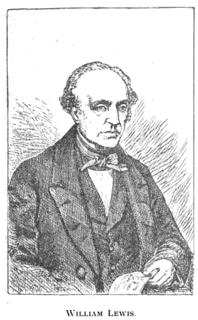
William Lewis (1787–1870) was an English chess player and author, nowadays best known for the Lewis Countergambit and for being the first player ever to be described as a Grandmaster of the game.

The City of New York, usually called either New York City (NYC) or simply New York (NY), is the most populous city in the United States. With an estimated 2017 population of 8,622,698 distributed over a land area of about 302.6 square miles (784 km2), New York is also the most densely populated major city in the United States. Located at the southern tip of the state of New York, the city is the center of the New York metropolitan area, the largest metropolitan area in the world by urban landmass and one of the world's most populous megacities, with an estimated 20,320,876 people in its 2017 Metropolitan Statistical Area and 23,876,155 residents in its Combined Statistical Area. A global power city, New York City has been described as the cultural, financial, and media capital of the world, and exerts a significant impact upon commerce, entertainment, research, technology, education, politics, tourism, art, fashion, and sports. The city's fast pace has inspired the term New York minute. Home to the headquarters of the United Nations, New York is an important center for international diplomacy.

The International Standard Book Number (ISBN) is a numeric commercial book identifier which is intended to be unique. Publishers purchase ISBNs from an affiliate of the International ISBN Agency.

